Students get through the MP Board Class 11th Biology Important Questions Chapter 6 Anatomy of Flowering Plants which are most likely to be asked in the exam.
MP Board Class 11th Biology Important Questions Chapter 6 Anatomy of Flowering Plants
Anatomy of Flowering Plants Class 11 Important Questions Very Short Answer Type
Question 1.
What is tissue?
Answer:
A group of cells which are similar in origin and performing a particular function is collectively called as tissue.
Question 2.
Write main elements present in phloem.
Answer:
The main elements present in phloem are :
Sieve tubes, companion cells, phloem fibres and phloem parenchyma.
![]()
Question 3.
What is meristematic tissue?
Answer:
It is the simple type of tissue, composed of similar and immature cells, which continuously divide and form new cells. This type of cells mostly present in the apical portion and help in the growth of plant body.
Question 4.
Vascular bundles are formed by which tissue?
Answer:
Vascular bundles are formed by xylem and phloem.
Question 5.
Differentiate exarch and endarch vascular bundles.
Or,
What do you mean by endarch and exarch vascular bundles?
Answer:
- Endarch V.B.: Vascular bundles, the protoxylem of which is arranged towards the periphery and metaxylem in the central region are called endarch V.B. e.g., V.B. of roots.
- Exarch V.B.: Vascular bundles, the protoxylem of which is aiTanged in the centre and metaxylem towards the peripheral region are called as exarch V.B. e.g., V.B. of stems.
Question 6.
Write the main functions of xylem.
Answer:
The main functions of xylem is to conduct the absorbed water and minerals by root from the soil and to provide mechanical support to the plant.
Question 7.
Where is xylem vessel found ? Write their functions.
Answer:
Xylem vessels are found in the xylem tissues of the vascular bundles. Xylem vessels are responsible for the conduction of absorbed substances.
Question 8.
Write the functions of pericycle.
Answer:
- It forms lateral roots.
- When composed of parenchymatous cells, it may act as storage region.
- In dicot roots, their cells become meristematic and forms part of the cambium.
- Thick walled pericycle gives rise to lateral and adventitious roots.
Question 9.
What is stomata?
Answer:
These are small openings on the surface of the leaf through which exchange of vapour and gases takes place. Stomata performs transpiration.
![]()
Question 10.
Which type of vascular bundles are found in the stem of sunflower plant?
Answer:
Conjoint, collateral, open type of vascular bundles are found in the stem of sunflower plant.
Question 11.
What is cambium? Give its function.
Answer:
Cambium is a meristematic tissue. During secondary growth, cells of cambium are divided to form secondary xylem towards inner side and secondary phloem towards outer side of it, thus plant part increases in thickness.
Question 12.
Where is cambium found?
Answer:
Cambium is found in the vascular bundle of dicot stem in between xylem and phloem as meristematic tissue.
Question 13.
Where guard cells are found? Give its function.
Answer:
Stomata (pores) found in the epidermis of leaves are surrounded by two kidney shaped guard cells. Guard cells regulate opening and closing of stomata.
Question 14.
What are Bast fibres?
Answer:
Sclerenchyma cells (fibres) found associated with phloem are called as Bast fibres or phloem fibres.
Question 15.
Write main elements present in xylem.
Answer:
The main elements present in xylem are :
- Xylem tracheids,
- Xylem tracheae (vessels),
- Xylem fibres (wood),
- Xylem parenchyma.
![]()
Question 16.
What is tissue system?
Answer:
In flowering plants group of tissues derived from meristematic tissue perform one or many functions together. This system of tissues is called as tissue system.
Question 17.
When transverse section of a part of a plant is observed under compound microscope following structures are observed :
(a) Conjoint vascular bundles, scattered and surrounded by sclerenchymatous sheath.
(b) Phloem parenchymatous.
Identify the plant part.
Answer:
This is transverse section of monocot stem.
Anatomy of Flowering Plants Class 11 Important Questions Short Answer Type
Question 1.
How is study of Anatomy useful to us?
Answer:
Study of external morphology helps us to find out similarity and differences between shape, structure and colour of the organism. Many organisms may look similar externally but may be different in structure internally.
Study of internal structure of plant or animal is called as Anatomy. It helps us to understand about different types of cells and tissues found in them and their arrangement in the plant part. It also helps us to understand about their functions. Such as epidermis helps for protection. Xylem and Phloem are located at the central part which help for conduction of water, minerals and food respectively.
Question 2.
How does structure and location of epidermal cells help the plants to per-form specific function?
Answer:
Epidermis is the outermost protective layer of plant organs. It is usually single layered. In stems and leaves this layer is protected by cuticle (made up of cutin a fatty substance).
Epidermal cells perform several functions, e.g. protection of stems and leaves, absorption (in roots), excretion, secretion, gaseous exchange and regulation of transpiration.
In some monocot leaves (such as grasses), epidermal cells become larger, thin walled and have vacuoles. Such cells are called as bulliform cells or motor cells. These cells brings about rolling of leaves during dry season and this reduces transpiration as in Ammophila, Zea mays etc.
![]()
Question 3.
What are the various types of meristems based on their locations? Give their functions.
Answer:
Following are the various types of meristems based on their location :
(i) Apical meristem :
It lies at the apex of the stem and the root of vascular plants, they may also be present at the apices of leaves. Due to its activity the organs increase in length. The growth begins by one or more cells found at the tip of the organ, these cells are called apical cells or apical initials, as they initiate the growth.
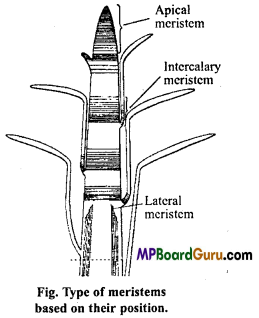
(ii) Intercalary meristem :
These are the portions of apical meristems that separate from the apex during development by layers of more mature or permanent tissues and left behind as the apical meristem moves on in growth. The intercalary meristems are intemodal in position. They are found lying in between masses of permanent tissues either at the leaf base or at the base of intemode. This type of meristem is found in stems of monocots. based on their position.
(iii) Lateral meristem :
It is composed of such initials which divide mainly in one plane (periclinal) and increase the diameter of an organ. They may add to the existing tissue or give rise to new tissues. The cambium and cork cambium are the examples of this type.
Question 4.
Write differences between following based on their anatomy :
(a) Dicot and monocot root
(b) Dicot and monocot stem.
Answer:
(a) Differences between Anatomy of Dicot and Monocot Roots

(b) Differences between Diocot and Monocot Stems
| Dicot Stem | Monocot Stem |
| 1. Epidermis contains multicellular hairs. | It does not contain multicellular hairs. |
| 2. Hypodermis is collenchymatous. | Hypodermis is sclerenchymatous. |
| 3. Endodermis and pericycle are present. | Endodermis and pericycle are absent. |
| 4. Vascular bundles are few and arranged in a ring. | Vascular bundles are many and scattered. |
| 5. Vascular bundles are open. | Vascular bundles are closed. |
| 6. Bundle sheath is absent. | Vascular bundles are covered by a prominent bundle sheath. |
| 7. Medullary rays and pith are present. | Medullary rays and pith are absent. |
| 8. Secondary growth takes place. | Secondary growth does not take place. |
| 9. Xylem vessels are arranged in radial rows. | Xylem vessels are arranged in the form of‘Y’. |
| 10. Phloem is made up of sieve tubes, companion cells and phloem parenchyma. | Phloem is made up of sieve tubes and companion cells only. |
| 11. Lysigenous cavity is absent. | Lysigenous cavity is present. |
![]()
Question 5.
Give four characteristics of meristematic tissue.
Answer:
A group of cells which is capable of showing division and redivisions is called as meristematic tissue. Following are the characteristics of meristematic tissue :
- Cells contain homogeneous thin wall.
- They contain large nuclei associated with abundant cytoplasm.
- Intercellular spaces are not present in between them.
- Cells contain dense protoplasm and do not contain vacuoles. These cells are found in active metabolic state.
Question 6.
Write differences between Vascular Bundles of Root and Stem.
Or,
Write differences between Radial and Conjoint Vascular Bundles.
Answer:
Differences between Radial and Conjoint Vascular Bundles
| Radial Vascular Bundle | Conjoint Vascular Bundle |
| 1. Xylem and phloem lie radially, alternately. | Xylem and phloem are present on same radius in one bundle. |
| 2. They lie on separate radii. | They lie on same radius. |
| 3. This type of vascular bundles are found in roots. | This type of vascular bundles are found in stems. |
Question 7.
What is Periderm? How is periderm formed in dicot stem?
Answer:
In many woody plants further increase in girth takes place by the formation of new tissues in extrastelar region (cortical region). These new tissues are called periderm or cork which were formed from some meristematic tissues called cork cambium or phellogen.
Periderm is made up of following three types of tissues :
1. Phellogen (cork cambium):
It is secondary lateral meristem arising from hypo- dermis or outer cortex. It consists of a single layer of narrow, thin walled rectangular mer¬istematic cells. The cork cambium cuts-off cells to its both the sides.
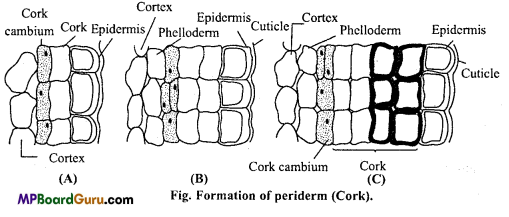
2. Phellem (cork):
The cells formed as a result of tangential and periclinal divisions of phellogen cells towards outer side, are called phellem or cork. The cork cells are
suberized and impervious to water and air. Cork cells also possess thermal insulating properties.
3. Phelloderm (secondary cortex):
The cells formed on inner side of the phellogen are called phelloderm or secondary cortex. It consists of parenchymatous cells which often contain chloroplast. Due to rapid growth of secondary cortex sometimes the general cortex is crushed.
![]()
Question 8.
Write short note on lenticel.
Answer:
Lenticels:
These are aerating pores formed in the bark, through which exchange of gases takes place. Externally they appear as scars on the surface of the stem. In the region of a lenticel, the cells cut off by the cork cambium towards the outside become rounded to form a loose mass with plenty of intercellular spaces. The tissue is known as complementary tissue. Through the lenticel, tissues inside the cork can communicate with the outside atmosphere.
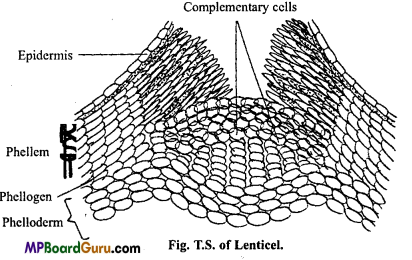
Question 9.
Write difference between anatomy of Dicot and Monocot leaves.
Answer:
Differences between Anatomy of Dicot and Monocot leaves
| Dicot Leaf | Monocot Leaf |
| 1. It is dorsiventral type and the number of stomata differ on both the surface of the leaf. | It is isobilateral type and number of stomata are more or less uniform on both the surface of the leaf. |
| 2. Mesophyll is differentiated into palisade parenchyma and spongy parenchyma. | Not differentiated. |
| 3. Bulliform cells are absent. | Bulliform cells are present in its epidermis and help in folding of leaves. |
| 4. On both the sides of larger vascular bundles parenchyma cells are found. | On both the sides of larger vascular bundles sclerenchyma cells are found. |
| 5. Bundle of sheath is generally single layered, cells are colourless | Bundle of sheath may be single or double. layered, cells generally possesses chloroplast. |
| 6. The stomata have kidney shaped guard cells. | The stomata have dumb-bell shaped guard cells. |
Question 10.
Why Xylem and Phloem are called as complex tissues?
Answer:
Complex permanent tissues:
Vascular tissues of plant are complex tissue, which help for conduction of various substances from one part of the plant to other part. Therefore, these are also called as conductive tissues.
Complex permanent tissue is a group of many types of the tissues, which functions as a unit together. Xylem and phloem are main examples of complex tissues.
Tissues which help in the conduction of water and minerals against gravitational force towards upsides are called xylem or wood and tissues which helps to translocate prepared food to different parts of plant are called as phloem or bast. As these tissues consist of more than one type of tissues, therefore they are called as complex tissues.
![]()
Anatomy of Flowering Plants Class 11 Important Questions Long Answer Type
Question 1.
Describe anatomy of dicot leaf (Dorsiventral) with labelled diagram.
Answer:
Anatomy of dicot (Dorsiventral) leaf: This type of leaves are commonly horizontal in orientation which contain distinct upper and lower surface. The upper surface which faces the sun is darker than the lower surface. The different parts are :
1. Upper epidermis :
It is made up of tightly packed rectangular barrel shaped, transparent parenchymatous cells in which chloroplast is absent. In this layer stomata are generally absent.
2. Mesophyll :
It is the ground tissue which is situated between upper and lower epidermis. It can be differentiated into two distinct layers.
(i) Palisade parenchyma :
This portion lies just next to the upper epidermis and are roughly rectangular in shape. They are remarkably placed at right angles to the surface of the leaf in order to absorb maximum sunlight for the process of photosynthesis. They are arranged in many parallel rows like palisade anji therefore also called as palisade mesophyll. They contain abundant chloroplast and help in photosynthesis.

(ii) Spongy parenchyma :
The cells of this region are irregular in shape and are not very compact in arrangement. They enclose large air spaces between them which give them spongy characteristic. These cells are simple parenchyma and hence this tissue is known as spongy parenchyma. The intercellular spaces of this tissue communicate with the external atmosphere through the stomata. These cells may develop chloroplast also.
3. Vascular bundles:
They are meant for distributing water and minerals to the lamina of the leaf. These vascular bundles are conjoint, collateral and endarch. The phloem is situated towards the abaxial side and protoxylem points towards the adaxial side. Each vascular bundle has its own vascular sheath around it.
4. Lower epidermis :
This layer is made of a single layer of compactly arranged rectangular, transparent parenchymatous cells. Lower epidermis contains large number of pores called stomata.
Question 2.
What is stomatal system? Describe structure of stomata with labelled diagram.
Answer:
Stomata are minute pores found on the epidermal layer of leaves and other green aerial parts of the plant body. Each stoma or aperture is bounded by two kidney shaped cells, called Guard cells. Guard cells are living and contain chloroplast. The outer wall of guard
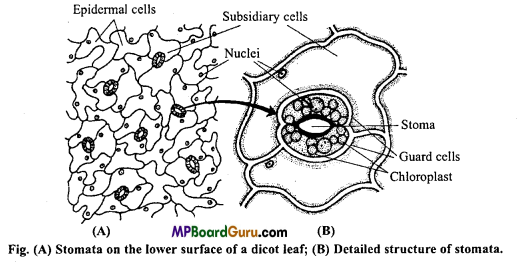
cell adjacent to epidermal cell wall is thin whereas the inner wall lying towards the stomata is thicker. In certain plants, some specialized epidermal cells are present. These cells are called Subsidiary or Accessory cells. Each stomata open below in a large cavity, called Sub-stomatal cavity.
In xerophytes, stomata are found sunken in grooves. This greatly reduces rate of transpiration. Function of stomata is exchange of gases and control of transpiration.
Stomatal pore, guard cells and subsidiary or accessory cells together form stomatal system.
![]()
Question 3.
Describe the process of secondary growth in the stem of woody angiosperms with labelled diagrams. Give its importance.
Answer:
Secondary growth :
Increase in thickness of the root and stem of dicot plants due to addition of secondary tissues by the activity of cambium and cork cambium is called as secondary growth.
Dicot plants convert into trees due to secondary growth and monocot plants cannot develop to form a tree due to absence of secondary growth. Except a few plants monocot do not shows secondary growth whereas dicot stem as well as root both shows secondary growth.
Secondary growth in dicot stem:
In a typical dicot stem secondary growth occurs in following ways:
1. Activity of cambium:
The vascular bundles in the dicot stem are open type, that is to say that bundles contain intrafascicular cambium in between xylem and phloem which is a primary meristem. The parenchymatous cells found in between the intrafascicular cambium of the adjacent bundles become meristematic to form strip of interfascicular cambium, which laterally join to the intrafascicular cambium to complete a circular ring of cambium. This is known as cambium ring.
Cambium ring cuts secondary phloem towards outside and secondary xylem towards inside.
Generally secondary xylem is produced in more quantity as compared to secondary phloem therefore cambium ring moves towards the periphery.

The primary phloem becomes crushed. Not only this, but there is a continuous collapsing and disintegration of the secondary phloem in its outer region and continuous addition in the inner region just outside the cambium ring. However, the amount of secondary xylem goes on increasing continuously.
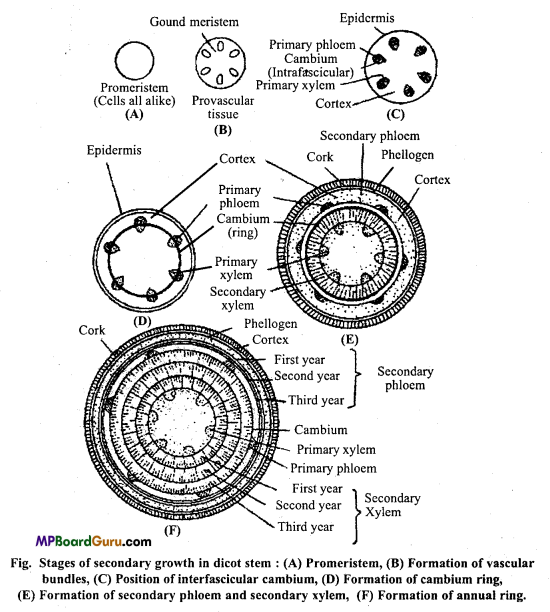
2. Formation of annual rings :
In annual herbs, there is little secondary growth. However, in the perennial plants, especially the arborescent ones, secondary growth is more or less continuous process. The process usually starts in the spring, the amount of wood which is formed during the spring and summer is much more than that formed during the winter. Further, the xylem elements which are formed during the spring and subsequent summer are larger in diameter than those formed during the winter.
The spring (or summer) wood is, therefore, lighter in colour and lesser in density in comparison to the winter wood which is comparatively darker in colour and greater in density. The sequence of spring and winter wood on a cut log of a wood is seen in the form of dark and light coloured concentric rings. One light and a dark coloured zone represents one years growth and is known as a growth ring or annual ring.
Thus, by counting the number of growth rings, one can estimate the age of the wood with a fair degree of correctness.
3. Cork cambium or Phellogen and its activity :
With the progressive increase in diameter of the secondary wood, the primary tissues outside the secondary phloem, including the cortex and the epidermis becomes greatly stretched and may even radially crack open. However before this eventuality arises, another cambium arises, in the cortex. This is the
cork cambium.
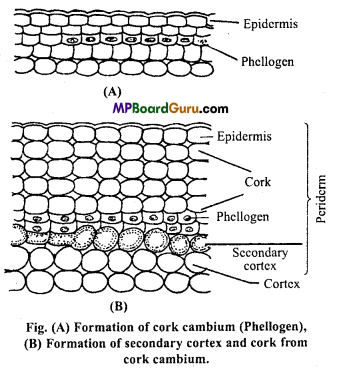
The cork cambium is completely secondary in nature.
The cells of the cork cambium are brick-shaped and tangentially elongated.
Derivatives are cut off both towards the outside, as well as towards the inside. The outer derivatives become suberized and lead to form the cork or phellem. The inner derivatives may slightly round up but remain arranged in radial rows. They develop plenty of chloroplasts and constitute the secondary cortex or Phelloderm. The cells of the secondary cortex can be distinguished from those of primary cortex by their arrangement in radial rows and presence of chloroplasts.
With the formation of cork which is impervious, both to water and air, all primary tissues of the stem outside the cork cambium are cut off from water supply, dry up and are ultimately shed.
The cork, cork cambium and secondary cortex are collectively known as periderm. Phellem tissue is impervious to water and provides protection to the underlying secondary tissues. In this cork cells certain areas of the cork remain thin walled and loosely arranged. They help in gaseous exchange and are called as lenticels. They are generally produced at the site of the stomata which were present in the young stem.
![]()
Question 4.
Differentiate the following :
(a) Vessel and TVacheids,
(b) Parenchyma and Collenchyma,
(c) Heart wood and Sap wood,
(d) Open and Closed Vascular bundle.
Answer:
(a) Differences between Vessels and Tracheids
| Vessels | Tracheids |
| 1. These are elongated tube like cells which are placed end to end with each other to form a tube. | These are single elongated cells. |
| 2. End of cells are round. | These are cells with tapering ends. |
| 3. Septa are found between two cells. | Septa between adjacent cells dissolve to form hollow pipes. |
| 4. Vessels are 1 to 6 mm in length. | These are only 1 mm in length. |
| 5. Its lumen is broad. Its lumen is narrow. | Its lumen is narrow. |
(b) Differences between Parenchyma and Collenchyma
| Parenchyma | Collenchyma |
| 1. Cells are spherical, oval or polygonal in shape. | Cells are polygonal, elongated or oval. |
| 2. Cells are always living. | Living. |
| 3. Cell wall is thin and made up of cellulose. | Cell wall contains high deposition of pectic materials. |
| 4. Cell wall thickening and intercellular space are absent. | Angular thickening on cell wall is present but intercellular space is absent. |
| 5. It is present in any tissue system of the plant body. | It is generally found in the cortex or hypodermis of dicot stem and also in leaves. |
| 6. Parenchymatous cells are involved in photosynthesis, storage and also in mechanical support in the form of ground tissue.materials. | It provides tensile strength to plant axis and may also be involved in photosynthesis and storage of food materials. |
| 7. Cells have the capacity of division. | Cells cannot divide. |
(c) Differences between Heartwood and Sapwood
| Heartwood | Sapwood |
| 1. It is found in the central part of the stem. | It is found towards the periphery surrounding heart wood. |
| 2. It is dark coloured. | It is light coloured. |
| 3. Cells are dead. | Cells are living. |
| 4. It provides mechanical strength to the plant. It helps in life activities. | It helps in life activities. |
| 5. It is very hard. | It is soft. |
| 6. It contains gum, oil, tannins and resins etc. in more quantity.- These substances are found in less quantity. | These substances are found in less quantity. |
| 1. It is found in the central part of the stem. | It is found towards the periphery surrounding heart wood. |
(d) Differences between Open and Closed Vascular Bundle
| Open Vascular bundle | Closed Vascular bundle |
| 1. When in a collateral vascular bundle cambium is present in between xylem and phloem, the bundle is called as Open Vascular Bundle. | When in a collateral vascular bundle cambium is absent, it is called as Closed Vascular Bundle. |
| 2. This type of vascular bundles are found in dicot stem. | This type of vascular bundles are found in monocot stem. |
![]()
Question 5.
You observe transverse section of young stem of a plant under compound microscope. How will you identify that it is dicot stem or monocot stem? Give reason for it.
Answer:
Dicot stem and Monocot stem can be identified by following characteristics :
The T.S. of a dicot stem shows following structures :
(1) Epidermis :
It is single layered, which produces multicellular hairs and are covered by cuticle.
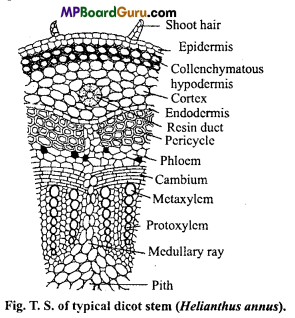
(2) Cortex:
It is below epidermis. The outer cortex is known as hypodermis and are generally made up of collenchyma. The inner cortex is made up of parenchymatous cells with intercellular space. Cortex is followed by single layered endodermis.
(3) Pericycle:
Below endodermis, parenchymatous pericycle is present.
(4) Vascular bundle:
Vascular bundles are made up of xylem, phloem and cambium arranged in the same radius. V.B. are conjoint, collateral, endarch and open. Xylem is made of xylem vessels, tracheids, wood fibres and xylem parenchyma. Phloem is made up of sieve tubes, companion cells and phloem paren¬chyma. A cambium ring is present between xylem and phloem.
(5) Pith :
It is very elaborated and occupies the major central portion of the stem and is composed of rounded or polygonal thin walled cells with intercellular spaces.
The anatomy or T.S. of monocot stem (maize stem) shows the following structures :
(i) Epidermis: It is an outermost layer of the stem which is single layered and without hairs. A layer of cuticle is present outside the epidermis.
(ii) Hypodermis : It is situated just below the epidermis and may be made up of 2 to 4 layers of sclerenchymatous cells.
(iii) Ground tissue: It is made up of parenchymatous cells with plenty of intercellular spaces. These cells are situated below the hypodermis and scattered up to the centre of stem.
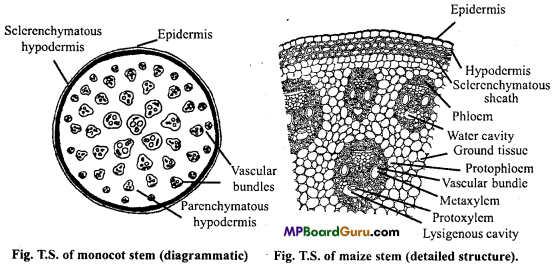
(iv) Vascular bundle :
In monocot stem, the vascular bundles are found to be scattered in the ground tissues. They are conjoint, collateral and closed. The xylem is endarch and the vessels are arranged in the form of the letter ‘Y\ the phloem being situated in between the two limbs of the ‘Y’ and consists of sieve tubes and companion cells only. Lysigenous cavity is found below the protoxylem in each vascular bundle.
(v) Pith : Pith is absent.
Question 6.
Describe various types of vascular bundles.
Answer:
Types of vascular bundles: According to the arrangement of xylem and phloem, the vascular bundles are of the following types :
1. Radial vascular bundle :
When xylem and phloem form separate bundles and lie on different radii alternating with each other, is said to be radial vascular bundles as in roots.
2. Conjoint vascular bundle :
When xylem and phloem combine into one bundle. There are different types of conjoint bundles :
(i) Collateral: When xylem and phloem lie together on the same radius, xylem being internal and phloem external. When in a collateral bundle the cambium is present, as in dicotyledonous stems, the bundle is said to be open and when the cambium is absent it is said to be closed, as in monocotyledonous stems.

(ii) Bicollateral vascular bundle :
When in a collateral bundle both phloem and cambium occur twice, once on the outer side of xylem and then again on its inner side. The sequence is outer phloem, outer cambium, xylem, inner cambium and inner phloem. Bicollateral bundle is characteristic of the ground family. It is always open.
3. Concentric vascular bundles:
These are those vascular bundles where one type of the tissue encircles or envelops the other tissue. They are again of two types :
- Amphivasal vascular bundles: When xylem surrounds the phloem as in Dracena and Yucca.
- Amphicribral vascular bundles : When phloem encircles the xylem as in Ferns.
![]()
Anatomy of Flowering Plants Class 11 Important Questions Objective Type
1. Choose the correct answers:
Question 1.
Radial vascular bundles are found in :
(a) Dicot stem
(b) Monocot stem
(c) Dicot root
(d) Monocot root.
Answer:
(d) Monocot root.
Question 2.
Bicollateral vascular bundles are found in :
(a) Liliaceae
(b) Cucurbitaceae
(c) Compositae
(d) Malvaceae.
Answer:
(a) Liliaceae
Question 3.
In amphivasal vascular bundles :
(a) Phloem is covered by xylem
(b) Xylem is covered by phloem
(c) Both are radially arranged
(d) None of these.
Answer:
(d) None of these.
Question 4.
In dicot vascular bundles are :
(a) Open, collateral and endarch
(b) Closed, collateral and endarch
(c) Open, collateral and exarch
(d) Closed, collateral and exarch.
Answer:
(a) Open, collateral and endarch
Question 5.
The chief function of velamen tissue is :
(a) Absorption of water from host plant
(b) Absorption of water from atmosphere
(c) Absorption of mineral salts
(d) None of these.
Answer:
(c) Absorption of mineral salts
Question 6.
The lateral meristem is responsible for :
(a) Increasing height
(b) Increasing thickness
(c) Increasing permanent tissue
(d) None of these.
Answer:
(b) Increasing thickness
Question 7.
Companion cells are associated with :
(a) Sieve tubes
(b) Xylem
(c) Collenchyma
(d) Cambium.
Answer:
(a) Sieve tubes
![]()
Question 8.
Tissue responsible for secondary growth is :
(a) Cambium
(b) Cortex
(c) Pericycle
(d) Endodermis.
Answer:
(a) Cambium
Question 9.
Secondary growth is found in :
(a) Monocot plants
(b) Dicot plants
(c) Both (a) and (b)
(d) Bryophytes.
Answer:
(b) Dicot plants
Question 10.
Phellogen forms:
(a) Phloem
(b) Xylem
(c) Cork
(d) Cork and secondary cortex.
Answer:
(d) Cork and secondary cortex.
Question 11.
Lenticel found in bark is :
(a) Air pore
(b) Vessel
(c) Tissue
(d) Stele.
Answer:
(a) Air pore
Question 12.
Annual ring is made up of:
(a) Spring wood
(b) Autumn wood
(c) Both (a) and (b)
(d) None of these.
Answer:
(c) Both (a) and (b)
Question 13.
Brick-shaped suberized cells found outside the cork cambium is :
(a) Secondary cortex
(b) Phellem
(c) Epidermis
(d) Endodermis.
Answer:
(b) Phellem
Question 14.
Balloon shaped structures present inside the vessels are called :
(a) Histogen
(b) Tyloses
(c) Phellogen
(d) Tunica.
Answer:
(b) Tyloses
![]()
Question 15.
Periderm includes :
(a) Cork cambium (phellogen), cork (phellem) and secondary cortex (phelloderm)
(b) Cork cambium and cork
(c) Cork
(d) Cork and secondary phloem.
Answer:
(a) Cork cambium (phellogen), cork (phellem) and secondary cortex (phelloderm)
Question 16.
The best method to determine the age of tree is to :
(a) Measure its diameter
(b) Count the number of leaves
(c) Count the number of annual rings at the base of main stem
(d) Find out the number of branches.
Answer:
(c) Count the number of annual rings at the base of main stem
Question 17.
Wood is common name of:
(a) Cambium
(b) Vascular bundles
(c) Phloem
(d) Secondary xylem.
Answer:
(d) Secondary xylem.
Question 18.
Where do casparian strips occur :
(a) Epidermis
(b) Endodermis
(c) Pericycle
(d) Phloem.
Answer:
(b) Endodermis
Question 19.
Dendrochronology is the study of:
(a) Height of tree
(b) Diameter of a tree
(c) Age of the tree by counting the number of annual rings in the main stem
(d) None of these.
Answer:
(b) Diameter of a tree
Question 20.
In roots, lateral branches grow from :
(a) Epiblema
(b) Pericycle
(c) Cortex
(d) Endodermis.
Answer:
(b) Pericycle
Question 21.
Sunken stomata occur in :
(a) Mesophytes
(b) Xerophytes
(c) Hygrophytes
(d) Hydrophytes.
Answer:
(b) Xerophytes
![]()
Question 22.
Polyarch and exarch condition is found in:
(a) Monocot stem
(b) Monocot root
(c) Dicot stem
(d) Dicot root.
Answer:
(b) Monocot root
Question 23.
Meristem present in a vascular bundle is:
(a) Fascicular/intrafascicular cambium
(b) Interfascicular cambium
(c) Phellogen
(d) Procambium.
Answer:
(b) Interfascicular cambium
Question 24.
Cork cambium is also called :
(a) Phelloderm
(b) Phellem
(c) Periderm
(d) Phellogen.
Answer:
(d) Phellogen.
Question 25.
Periderm is produced by:
(a) Vascular cambium
(c) Phèllogen
(b) Fascicular cambium
(d) Intrafascicular cambium.
Answer:
(c) Phellogen
Question 26.
Endodermis of dicot stem is also called :
(a) Bundle sheath
(b) Starch sheath
(c) Mesophyll
(d) Water channel.
Answer:
(b) Starch sheath
Question 27.
Tyloses are thickenings seen in :
(a) Ray parenchyma
(b) Collenchyma
(c) Phloem cells
(d) Ray parenchyma and xylem cells.
Answer:
(d) Ray parenchyma and xylem cells.
Question 28.
Casparian strips contain :
(a) Cutin
(b) Pectin
(c) Suberin
(d) Wax.
Answer:
(c) Suberin
![]()
Question 29.
A component of xylem is:
(a) Seive tube
(b) Medullary ray
(c) Sclereid
(d) Tracheid.
Answer:
(d) Tracheid.
Question 30.
Vascular bundles occur in a ring in :
(a) Monocot stem
(b) leaf
(c) Root
(d) Dicot stem.
Answer:
(d) Dicot stem.
Question 31.
Secondary xyLem is:
(a) Bast
(b) Bark
(c) Cork
(d) Wood.
Answer:
(d) Wood.
Question 32.
Gymnosperm wood is soft as it:
(a) Lacks cambium
(b) Lacks vessels
(e) Does not yield timber
(d) None of the above.
Answer:
(b) Lacks vessels
Question 33.
Branch of Botany dealing with internal organization of plants is :
(a) Physiology
(b) Anatomy
(c) Ecology
(d) Cytology.
Answer:
(b) Anatomy
Question 34.
Phellogen is also knwon as :
(a) Vascular cambium
(b) Periderm
(c) Cork cambium
(d) Apical meristem.
Answer:
(c) Cork cambium
Question 35.
In an annual ring, the light coloured part in :
(a) Heartwood
(b) Sap wood
(c) Early wood
(d) Late wood.
Answer:
(b) Sap wood
![]()
Question 36.
Which is not a part of periderm :
(a) Phellogen
(b) Cork
(c) Secondary cortex
(d) Wood.
Answer:
(d) Wood.
Question 37.
Palisade parenchyma is absent in leaves of: (CBSE 2009)
(a) Gram
(b) Soyabean
(c) Sorghum
(d) Mustard.
Answer:
(c) Sorghum
2. Fill in the blanks:
(A)
1. Phellogen form the ………………….
Answer:
Cork and secondary cortex
2. Arenchyma is a kind of ………………….
Answer:
Parenchyma
3. Bicollateral vascular bundles are found in …………………..
Answer:
Liliaceae
4. Radial vascular bundles are found in …………………..
Answer:
Monocot root
5. Living member of the phloem tissue is ……………………
Answer:
Companion cells
![]()
(B) Fill in the blanks :
1. Dermatogen, Periblem and Plerome are found in …………………
Answer:
Root apex and stem apex
2. Bladder like ingrowths in the xylem vessels are called as ………………..
Answer:
Tyloses
3. Latex vessels are found in ………………….
Answer:
Cortex
4. Increase in ……………… of stem and root of dicot plants is called as secondary growth.
Answer:
Thickness
5. Secondary growth occurs due to activity of ………………..
Answer:
Cambium and cork cambium
6. Cortex consists of ………………. tissue.
Answer:
Parenchyma
7. Annual ring in plants is formed due to ………………. and ……………..
Answer:
Spring wood, autumn wood
8. ……………….. and …………… are vascular tissues.
Answer:
Xylem, phloem
![]()
9. Companion cells are found in …………………
Answer:
Phloem
10. Radial vascular bundles are found in ……………….
Answer:
Roots
3. Match the following:
(A)
| Column ‘A’ | Column ‘B’ |
| 1.Heartwood | (a) Phellogen |
| 2. Sieve tube | (b) Bark |
| 3. Periderm | (c) Functional wood |
| 4. Lenticels | (d) Non-functional wood |
| 5. Sapwood | (e) Phloem. |
Answer:
1. (d) Non-functional wood
2. (e) Phloem
3. (a) Phellogen
4. (b) Bark
5. (c) Functional wood
(B)
| Column ‘A’ | Column ‘B’ |
| 1. Dicot stem | (a) Conjoint, collateral, closed vascular bundle |
| 2. Dicot root | (b) Bulliform cells |
| 3. Monocot stem | (c) Conjoint, collateral, open vascular bundle |
| 4. Monocot root | (d) Radial, less than 6 vascular bundles |
| 5. Monocot leaf | (e) Radial, more than 6 vascular bundles. |
Answer:
1. (c) Conjoint, collateral, open vascular bundle
2. (d) Radial, less than 6 vascular bundles
3. (a) Conjoint, collateral, closed vascular bundle
4. (e) Radial, more than 6 vascular bundles.
5. (b) Bulliform cells
![]()
(C)
| Column ‘A’ | Column ‘B’ |
| 1. Isobilateral leaf | (a) Dicot plant |
| 2. Tyloses | (b) Broad and large vessels |
| 3. Dorsiventral leaf | (c) Narrow and small vessels |
| 4. Autumn wood | (d) Conjoint, collateral, closed vascular bundle |
| 5. Spring wood | (e) Ingrowth in the xylem. |
Answer:
1. (d) Conjoint, collateral, closed vascular bundle
2. (e) Ingrowth in the xylem.
3. (a) Dicot plant
4. (c) Narrow and small vessels
5. (b) Broad and large vessels
(D)
| Column ‘A’ | Column ‘B’ |
| 1. Cambium | (a) Periderm |
| 2. Cork cambium | (b) Secondary vascular bundle |
| 3. Xylem vessels | (c) Companion cells |
| 4. Sieve tubes | (d) Tyloses. |
Answer:
1. (b) Secondary vascular bundle
2. (a) Periderm
3. (d) Tyloses.
4. (c) Companion cells
(E)
| Column ‘A’ | Column ‘B’ |
| 1. Apical meristem | (a) Cork cambium |
| 2. Intercalary meristem | (b) Sunflower stem |
| 3. Secondary meristem | (c) Maize root |
| 4. Collateral and Open | (d) Root apex |
| 5. Radial | (e) Internode. |
Answer:
1. (d) Root apex
2. (e) Internode.
3. (a) Cork cambium
4. (b) Sunflower stem
5. (c) Maize root
![]()
4. Write true or false:
1. Intercalary meristem occurs in Mint and Grasses.
Answer:
True
2. The xylem having protoxylem towards the centre is called exarch.
Answer:
False
3. Casparian strip is found in passage cells.
Answer:
True
4. The complex tissue includes scierenchyma.
Answer:
False
5. In dicot vascular bundles are open, collateral and endarch.
Answer:
True
6. Secondary growth is not found in monocot plants.
Answer:
True
7. Cork cambium is formed in vascular bundles.
Answer:
False
8. Cork cambium is also known as phellogen.
Answer:
True
9. Heartwood is commercially more important.
Answer:
True
10. Autumn ring is more prominent than spring ring.
Answer:
False
11. Radial vascular bundles are found in dicotyledonous stem.
Answer:
False
![]()
12. Lenticels are the pores on the surface of bark of stem.
Answer:
True
13. Isobilateral leaves are found in dicot plants.
Answer:
False
5. Answer in one word:
1. The cell wall of xylem is rich in …………………..
Answer:
Lignin
2. Tissue responsible for secondary growth is ………………..
Answer:
Cambium
3. Tyloses thickening are seen in …………………
Answer:
Ray Parenchyma and Xylem cells
4. Which tissues have only living cells?
Answer:
Parenchyma
5. Brick shaped suberized cells found outside the cork cambium is …………………
Answer:
Cork
6. Abnormal secondary growth is found in ………………..
Answer:
Dracena
![]()
7. The tissue responsible for translocation of food material is ……………….
Answer:
Sieve tubes
8. In trees, the growth rings represent………………..
Answer:
Age
9. Vascular cambium and cork cambium are…………………
Answer:
Meristemâtic tissues
10. Maximum activity of cambium is during………………….
Answer:
Summer
11. Write the name of vascular tissue of plants which is non-living.
Answer:
Xylem